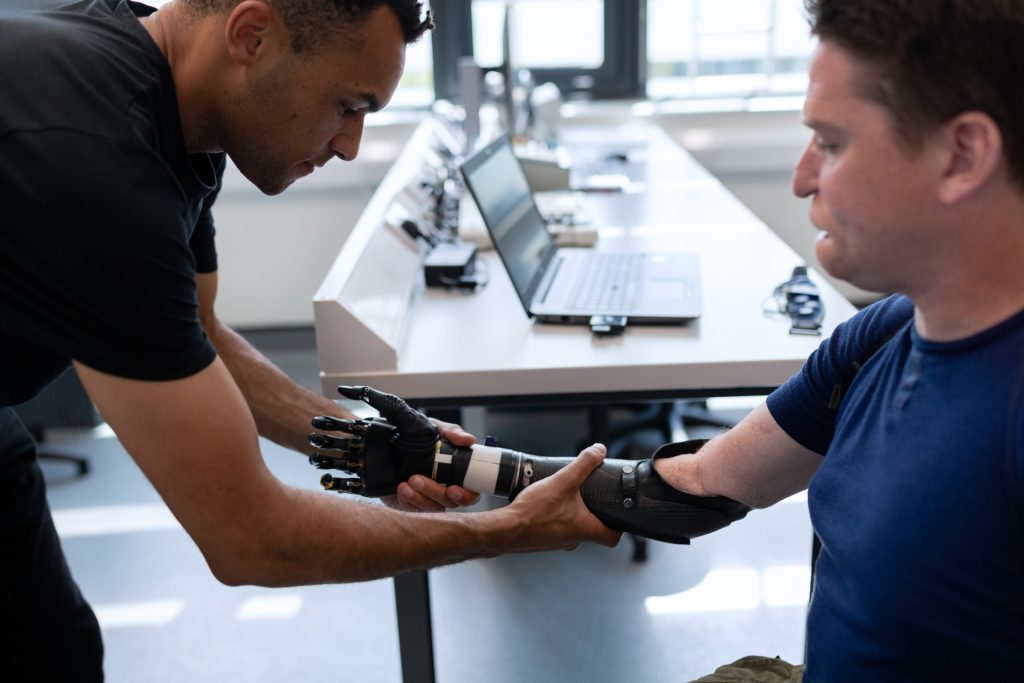
Researchers have developed a bionic arm for patients with upper-limb amputations that allows wearers to think, behave and function like a person without an amputation.
The arm combines three important functions – intuitive motor control, touch and grip kinaesthesia, the intuitive feeling of opening and closing the hand. The developers, led by Clevelend Clinic, published their findings in Science Robotics.
“We modified a standard-of-care prosthetic with this complex bionic system which enables wearers to move their prosthetic arm more intuitively and feel sensations of touch and movement at the same time,” said lead researcher Paul Marasco, PhD, associate professor in Cleveland Clinic Lerner Research Institute’s Department of Biomedical Engineering. “These findings are an important step towards providing people with amputation with complete restoration of natural arm function.”
The system is the first to test all three sensory and motor functions in a neural-machine interface simultaneously in a prosthetic arm. The neural machine interface sends impulses from the brain to the arm and sensory information back to the brain.
“Perhaps what we were most excited to learn was that they made judgments, decisions and calculated and corrected for their mistakes like a person without an amputation,” said Dr Marasco. “With the new bionic limb, people behaved like they had a natural hand. Normally, these brain behaviors are very different between people with and without upper limb prosthetics.
The researchers tested their new bionic limb on two study participants with upper limb amputations who had previously undergone targeted sensory and motor reinnervation -procedures that establish a neural-machine interface by redirecting amputated nerves to remaining skin and muscles.
In targeted sensory reinnervation, touching the skin with small robots activates sensory receptors that enable patients to perceive the sensation of touch. In targeted motor reinnervation, when patients think about moving their limbs, the reinnervated muscles communicate with a computerised prosthesis to move in the same way. Additionally, small, powerful robots vibrate kinesthetic sensory receptors in those same muscles which helps prosthesis wearers feel that their hand and arm are moving. The new prosthetic arm feels grip movement sensation, touch on the fingertips, and is controlled intuitively by thinking. Cameras lets the computer see the prosthetic’s position.
While wearing the advanced prosthetic, participants performed tasks reflective of basic, everyday behaviours that require hand and arm functionality, which were compared to people with traditional prosthetics and people without amputations.
According to Dr Marasco, because the limb lacks sensation, people with traditional prosthetics behave differently than people without an amputation when performing tasks. For example, traditional prosthesis wearers must constantly watch their prosthetic while using it, and have difficulty correcting for the correct amount of force needed.
The researchers could see that the study participants’ brain and behavioural strategies changed to match those of a person without an amputation. They no longer needed to watch their prosthesis, they could locate things without looking, and they could more effectively correct mistakes.
“Over the last decade or two, advancements in prosthetics have helped wearers to achieve better functionality and manage daily living on their own,” said Dr. Marasco. “For the first time, people with upper limb amputations are now able to again ‘think’ like an able-bodied person, which stands to offer prosthesis wearers new levels of seamless reintegration back into daily life.”
Source: Cleveland Clinic

